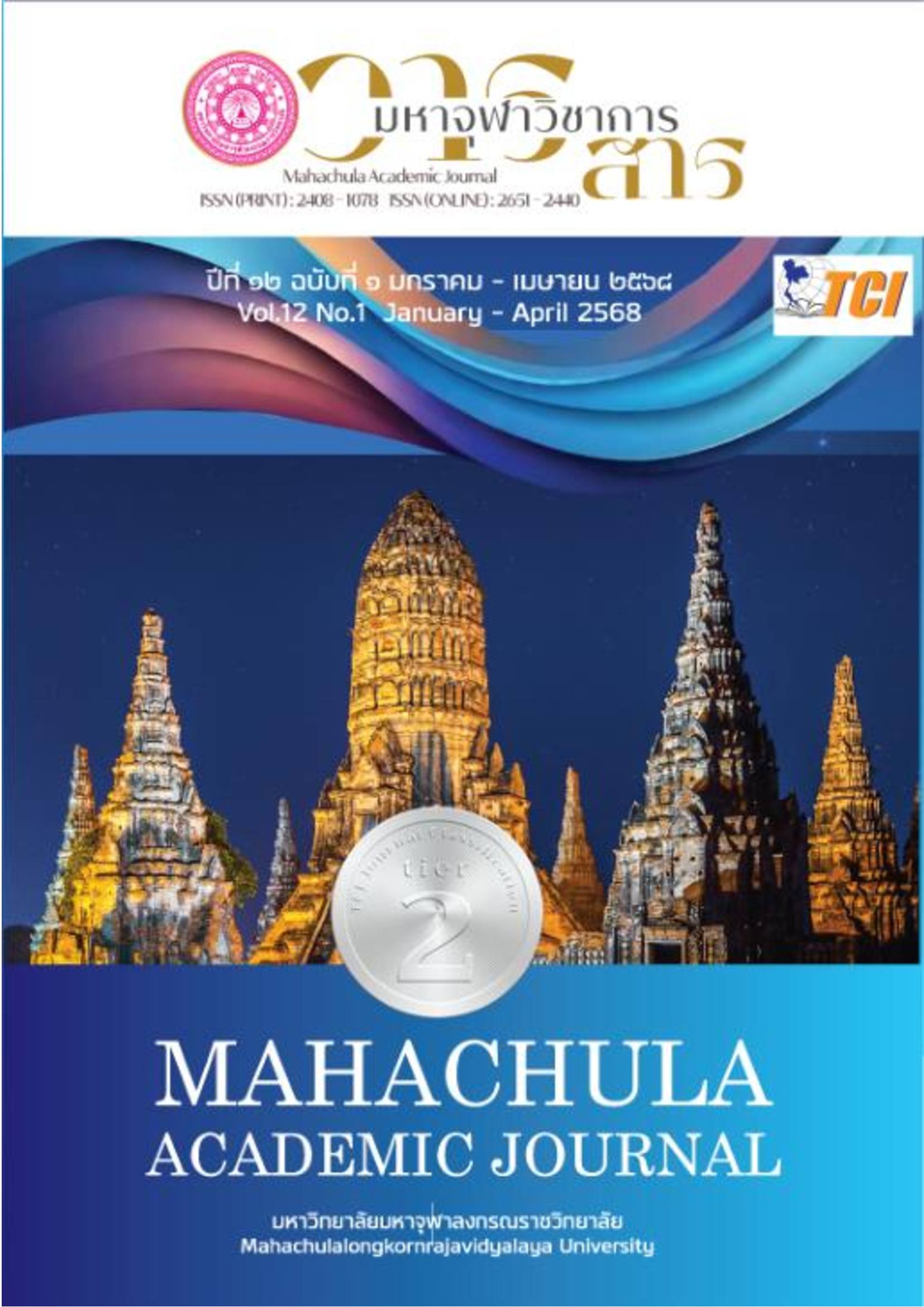A Study of Meditation Practice in the Commentary on the Dhammapada: A Case Study of the Sahassavagga
Main Article Content
Abstract
The research titled has three objectives: (1) to study meditation exercises as presented in Buddhist scriptures, (2) to examine the structure and content of the Sahassavagga, and (3) to analyze the principles of meditation in the Sahassavagga. This research is a documentary study
The findings reveal that (1) Buddhist meditation exercises are of two types: Samatha (tranquility meditation) and Vipassanā (insight meditation). On the one hand, Samatha meditation is practiced within the framework of 40 meditation objects, leading to a calm and concentrated mind, on the other hand, Vipassanā meditation is practiced by contemplating on Nāma and Rūpa within the framework of three characteristics of existence: impermanence (anicca), suffering (dukkha), and non-self (anatta). (2) The structure and content of the Sahassavagga involve narratives about various individuals and teachings (verses) that the Buddha delivered. There are 14 stories in total, including those of the man who killed a red-bearded robber, Bhāhiyadārucīriya Thera, Kundaḷakesi Theri, the brahmin Anāthapucchaka, the uncle of Sāriputta Thera, the nephew of Sāriputta Thera, the friend of Sāriputta Thera, Āyuvaddhana Kumāra, the novice Saṅkicca, Khāṇukoṇḍañña Thera, Sappadāsa Thera, Paṭācārā Theri, Kisāgotamī Theri, and Bahuputtikā Theri. (3) The meditation teachings in the Sahassavagga emphasize the comparison of a meaningful word, teaching, or verse to useless hundreds or thousand words where words that are beneficial involve discussing the aggregates (khandhas), elements (dhātus), sense bases (āyatanas), faculties (indriyas), powers (balas), factors of enlightenment (bojjhaṅgas), the foundations of mindfulness (satipaṭṭhānas), and Nibbāna. These teachings are subjects of insight meditation, focusing on the awareness of the arising and ceasing of physical and mental phenomena according to the three characteristics of existence: impermanence, suffering, and non-self. The Buddha delivered these profound teachings to both householders and monastics, conveying that even one meaningful word can lead listeners to attain the ultimate goals: the path, fruition, and Nibbāna. If the primary goal is not yet achieved, the secondary attainment is the celestial realm.
Article Details

This work is licensed under a Creative Commons Attribution-NonCommercial-NoDerivatives 4.0 International License.
References
จรุงใจ เกรียงบูรพา. “การปฏิบัติกัมมัฏฐานเพื่อรักษาตนตามแนวอัตตวรรคในอรรถกถาธรรมบท”. วิทยานิพนธ์พุทธศาสตรมหาบัณฑิต. บัณฑิตวิทยาลัย: มหาวิทยาลัยมหาจุฬาลงกรณราชวิทยาลัย, ๒๕๖๖.
จิณัฐตา ฐิตวัฒน์. “วิเคราะห์กรรมฐานในอัปปมาทวรรคและจิตตวรรค”. วิทยานิพนธ์พุทธศาสตรมหาบัณฑิต. บัณฑิตวิทยาลัย: มหาวิทยาลัยมหาจุฬาลงกรณราชวิทยาลัย, ๒๕๖๔.
พระธรรมธีรราชมหามุนี (โชดก ญาณสิทธิ). ความเป็นมาของวิปัสสนากัมมัฏฐาน. กรุงเทพมหานคร: โรงพิมพ์มหาจุฬาลงกรณราชวิทยาลัย, ๒๕๓๘.
พระนาถ โพธิญาโณ (โปทาสาย). “ศึกษาวิเคราะห์ความสำคัญของคัมภีร์อรรถกถาที่มีต่อ การศึกษาพระไตรปิฎก”. วิทยานิพนธ์ปริญญาพุทธศาสตรมหาบัณฑิต สาขาวิชาพระพุทธศาสนา. บัณฑิตวิทยาลัย: มหาวิทยาลัยมหาจุฬาลงกรณราชวิทยาลัย, ๒๕๖๒.
มหาจุฬาลงกรณราชวิทยาลัย. พระไตรปิฎกภาษาบาลี ฉบับมหาจุฬาเตปิฏกํ ๒๕๐๐. กรุงเทพมหานคร: โรงพิมพ์มหาจุฬาลงกรณราชวิทยาลัย, ๒๕๓๕.
มหาจุฬาลงกรณราชวิทยาลัย. พระไตรปิฎกภาษาไทย ฉบับมหาจุฬาลงกรณราชวิทยาลัย. กรุงเทพมหานคร: โรงพิมพ์มหาจุฬาลงกรณราชวิทยาลัย, ๒๕๓๙.
สมเด็จพระญาณสังวร สมเด็จพระสังฆราช สกลมหาสังฆปริณายก. แนวปฏิบัติในสติปัฏฐาน. พิมพ์ครั้งที่ ๘. นครปฐม: โรงพิมพ์มหามกุฏราชวิทยาลัย, ๒๕๕๕.

